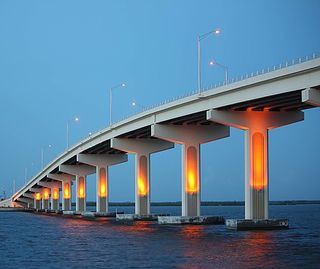Indian River Bridges: Difference between revisions
mNo edit summary |
|||
| Line 23: | Line 23: | ||
|where=Water LIKE 'Indian River' | |where=Water LIKE 'Indian River' | ||
|format=dynamic table | |format=dynamic table | ||
|hidden fields=Road,FDOT | |||
|details fields=Description,Article | |details fields=Description,Article | ||
}} | }} | ||
</div> | </div> | ||
==Bridge Info Box== | ==Bridge Info Box== | ||
<div> | <div> | ||
Revision as of 09:49, October 24, 2020
Bridges and Causeways that cross the Indian River.
About
Until 1920, there were only two bridges spanning across the Indian River, one in Brevard County's Cocoa and the second in Martin County's Hobe Sound. On Labor Day in 1920, a new wooden Vero Bridge opened and access to the ocean was available to all who lived on the Vero mainland. For boat traffic, a bridge tender, who lived in a house near the middle of the crossing, would open the metal swing span by hand. Tolls were charged to cross the bridge, ranging from 5 cents for pedestrians, 10 cents for horses and 35 cents for delivery trucks.[1]
In 1925, construction began on the first wooden bridge across the Indian River Lagoon in Eau Gallie. On February 22, 1926, the bridge opened to vehicle traffic headed to a sand trail at Canova Beach. There was no railing on the bridge for a year after its construction. There are no records that anyone fell off the bridge during this time.[2]
Post War 1940's the U.S. government funded construction of new bridges across the Indian River. As Florida's population grew, more traffic headed to the barrier islands, and modern bridges created from steel and concrete were constructed. These early concrete and steel bridges used earthen berths to partially span the river, with a lift or swing drawbridge in the middle to allow tall boats to pass. A boat unable to pass under the bridge would signal the tender, who was in a shack hanging off the bridge's side, to open the drawbridge so they could pass through. In less populated areas, the drawbridges were unattended at night and boats would have to anchor, and await the bridge tender's return the next morning.
A lagoon does not have a typical river type current, their water is only moved by wind and a minor tidal flow. Earthen berm causeways contribute to the Indian River's health problems by impeding the lagoon's water flow, limiting it's ability to flush out stagnant water containing algae, bacteria, dead seagrass and pollutants. Recently the river's communities have recognized the harm these old berm bridges cause, and are requiring high rise bridges that span the entire river.
Bridge Info Table
Indian River Bridges and Causeways
Function: CargoSQLQuery::run Query: SELECT CONCAT( Name,' (info)') AS `Name`,`Road` AS `Road`,`County` AS `County`,CONCAT(FDOT) AS `FDOT`,`Description` AS `Description`,`Article` AS `Article` FROM `cargo__bridge` WHERE Water LIKE 'Indian River' ORDER BY CONCAT( Name,' (info)'),`Road`,`County`,CONCAT(FDOT),`Description` LIMIT 100
Bridge Info Box
No results

